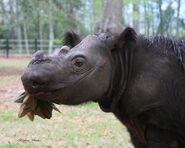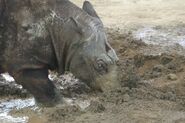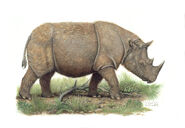
A Sumatran rhino living in the wild.
The Sumatran rhinoceros, also known as the hairy rhinoceros or Asian two-horned rhinoceros (Dicerorhinus sumatrensis), is a rare member of the family Rhinocerotidae and one of five extant rhinoceroses. It is the only extant species of the genus Dicerorhinus. It is the smallest rhinoceros, although it is still a large mammal; it stands 112–145 cm (3.67–4.76 ft) high at the shoulder, with a head-and-body length of 2.36–3.18 m (7.7–10.4 ft) and a tail of 35–70 cm (14–28 in). The weight is reported to range from 500 to 1,000 kg (1,100 to 2,200 lb), averaging 700–800 kg (1,500–1,800 lb), although there is a single record of a 2,000 kg (4,400 lb) specimen. Like both African species, it has two horns; the larger is the nasal horn, typically 15–25 cm (5.9–9.8 in), while the other horn is typically a stub. A coat of reddish-brown hair covers most of the Sumatran rhino's body.
Members of the species once inhabited rainforests, swamps, and cloud forests in India, Bhutan, Bangladesh, Myanmar, Laos, Thailand, Malaysia, Indonesia, and China. In historical times, they lived in southwest China, particularly in Sichuan. They are now critically endangered, with only five substantial populations in the wild: four on Sumatra and one on Borneo. Their numbers are difficult to determine because they are solitary animals that are widely scattered across their range, but they are estimated to number fewer than 100. Survival of the Peninsular Malaysia population is in doubt, and one of the Sumatran populations may already be extinct. Total numbers today may be as low as 80. In 2015, researchers announced that the Bornean rhinoceros had become extinct from the northern part of Borneo (Sabah, Malaysia); however, a new population was discovered in East Kalimantan in early 2016.
The Sumatran rhino is a mostly solitary animal except for courtship and offspring-rearing. It is the most vocal rhino species and also communicates through marking soil with its feet, twisting saplings into patterns, and leaving excrement. The species is much better studied than the similarly reclusive Javan rhinoceros, in part because of a program that brought 40 Sumatran rhinos into captivity with the goal of preserving the species. The program was considered a disaster even by its initiator; most of the rhinos died and no offspring were produced for nearly 20 years, representing an even worse population decline than in the wild. In March 2016, a Sumatran rhinoceros was spotted in Indonesian Borneo.
Description[]
A mature Sumatran rhino stands about 120–145 cm (3.94–4.76 ft) high at the shoulder, has a body length of around 250 cm (8.2 ft), and weighs 500–800 kg (1,100–1,800 lb), though the largest individuals in zoos have been known to weigh as much as 2,000 kilograms (4,400 lb). Like the African species, it has two horns. The larger is the nasal horn, typically only 15–25 cm (5.9–9.8 in), though the longest recorded specimen was much longer at 81 cm (32 in). The posterior horn is much smaller, usually less than 10 cm (3.9 in) long, and often little more than a knob. The larger nasal horn is also known as the anterior horn; the smaller posterior horn is known as the frontal horn. The horns are dark grey or black in color. The males have larger horns than the females, though the species is not otherwise sexually dimorphic. The Sumatran rhino lives an estimated 30–45 years in the wild, while the record time in captivity is a female D. lasiotis, which lived for 32 years and 8 months before dying in the London Zoo in 1900.
Two thick folds of skin encircle the body behind the front legs and before the hind legs. The rhino has a smaller fold of skin around its neck. The skin itself is thin, 10–16 mm (0.39–0.63 in), and in the wild, the rhino appears to have no subcutaneous fat. Hair can range from dense (the most dense hair in young calves) to scarce, and is usually a reddish-brown. In the wild, this hair is hard to observe because the rhinos are often covered in mud. In captivity, however, the hair grows out and becomes much shaggier, likely because of less abrasion from walking through vegetation. The rhino has a patch of long hair around its ears and a thick clump of hair at the end of its tail. Like all rhinos, they have very poor vision. The Sumatran rhinoceros is fast and agile; it climbs mountains easily and comfortably traverses steep slopes and riverbanks.
Distribution and Habitat[]
A mature Sumatran rhino stands about 120–145 cm (3.94–4.76 ft) high at the shoulder, has a body length of around 250 cm (8.2 ft), and weighs 500–800 kg (1,100–1,800 lb), though the largest individuals in zoos have been known to weigh as much as 2,000 kilograms (4,400 lb). Like the African species, it has two horns. The larger is the nasal horn, typically only 15–25 cm (5.9–9.8 in), though the longest recorded specimen was much longer at 81 cm (32 in). The posterior horn is much smaller, usually less than 10 cm (3.9 in) long, and often little more than a knob. The larger nasal horn is also known as the anterior horn; the smaller posterior horn is known as the frontal horn. The horns are dark grey or black in color. The males have larger horns than the females, though the species is not otherwise sexually dimorphic. The Sumatran rhino lives an estimated 30–45 years in the wild, while the record time in captivity is a female D. lasiotis, which lived for 32 years and 8 months before dying in the London Zoo in 1900.
Two thick folds of skin encircle the body behind the front legs and before the hind legs. The rhino has a smaller fold of skin around its neck. The skin itself is thin, 10–16 mm (0.39–0.63 in), and in the wild, the rhino appears to have no subcutaneous fat. Hair can range from dense (the most dense hair in young calves) to scarce, and is usually a reddish-brown. In the wild, this hair is hard to observe because the rhinos are often covered in mud. In captivity, however, the hair grows out and becomes much shaggier, likely because of less abrasion from walking through vegetation. The rhino has a patch of long hair around its ears and a thick clump of hair at the end of its tail. Like all rhinos, they have very poor vision. The Sumatran rhinoceros is fast and agile; it climbs mountains easily and comfortably traverses steep slopes and riverbanks.
Distribution and Habitat[]
The Sumatran rhinoceros lives in both lowland and highland secondary rainforest, swamps, and cloud forests. It inhabits hilly areas close to water, particularly steep upper valleys with copious undergrowth. The Sumatran rhinoceros once inhabited a continuous range as far north as Burma, eastern India, and Bangladesh. Unconfirmed reports also placed it in Cambodia, Laos, and Vietnam. All known living animals occur in Peninsular Malaysia, the island of Sumatra, and Sabah, Borneo. Some conservationists hope Sumatran rhinos may still survive in Burma, though it is considered unlikely. Political turmoil in Burma has prevented any assessment or study of possible survivors. The last reports of stray animals from Indian limits were in 1990s.
The Sumatran rhino is widely scattered across its range, much more so than the other Asian rhinos, which has made it difficult for conservationists to protect members of the species effectively. Only five areas are known to contain Sumatran rhinoceros: Bukit Barisan Selatan National Park, Gunung Leuser National Park, and Way Kambas National Park on Sumatra; Danum Valley in Sabah, Malaysia, on the island of Borneo, and on Indonesian Borneo west of Samarindah.
The Kerinci Seblat National Park, Sumatra's largest, was estimated to contain a population of around 500 rhinos in the 1980s, but due to poaching, this population is now considered extinct. The survival of any animals in Peninsula Malaysia is extremely unlikely.
Genetic analysis of Sumatran rhino populations has identified three distinct genetic lineages. The channel between Sumatra and Malaysia was not as significant a barrier for the rhinos as the Barisan Mountains along the length of Sumatra, for rhinos in eastern Sumatra and Peninsular Malaysia are more closely related than the rhinos on the other side of the mountains in western Sumatra. In fact, the eastern Sumatra and Malaysia rhinos show so little genetic variance, the populations were likely not separate during the Pleistocene, when sea levels were much lower and Sumatra formed part of the mainland. Both populations of Sumatra and Malaysia, however, are close enough genetically that interbreeding would not be problematic. The rhinos of Borneo are sufficiently distinct that conservation geneticists have advised against crossing their lineages with the other populations. Conservation geneticists have recently begun to study the diversity of the gene pool within these populations by identifying microsatellite loci. The results of initial testing found levels of variability within Sumatran rhino populations comparable to those in the population of the less endangered African rhinos, but the genetic diversity of Sumatran rhinos is an area of continuing study.
Although the rhino had been thought to be extinct in Kalimantan since the 1990s, in March 2013 World Wildlife Fund (WWF) announced that the team when monitoring orangutan activity found in West Kutai Regency, East Kalimantan, several fresh rhino foot trails, mud holes, traces of rhino-rubbed trees, traces of rhino horns on the walls of mud holes, and rhino bites on small branches. The team also identified that rhinos ate more than 30 species of plants. On 2 October 2013, video images made with camera traps showing the Sumatran rhino in Kutai Barat, Kalimantan, were released by the World Wildlife Fund. Experts assume the videos show two different animals, but aren't quite certain. According to the Indonesia's Minister of Forestry, Zulkifli Hasan called the video evidence "very important" and mentioned Indonesia's "target of rhino population growth by three percent per year". On 22 March 2016 it was announced by the WWF that a live Sumatran Rhino was found in Kalimantan; it was the first contact in over 40 years. The rhino, a female, is being transported to a nearby sanctuary.
Behavior[]
Sumatran rhinoceroses are solitary creatures except for pairing before mating and during offspring rearing. Individuals have home ranges; bulls have territories as large as 50 km2 (19 sq mi), whereas females' ranges are 10–15 km2 (3.9–5.8 sq mi). The ranges of females appear to be spaced apart; males' ranges often overlap. No evidence indicates Sumatran rhinos defend their territories through fighting. Marking their territories is done by scraping soil with their feet, bending saplings into distinctive patterns, and leaving excrement. The Sumatran rhino is usually most active when eating, at dawn, and just after dusk. During the day, they wallow in mud baths to cool down and rest. In the rainy season, they move to higher elevations; in the cooler months, they return to lower areas in their range. When mud holes are unavailable, the rhino will deepen puddles with its feet and horns. The wallowing behaviour helps the rhino maintain its body temperature and protect its skin from ectoparasites and other insects. Captive specimens, deprived of adequate wallowing, have quickly developed broken and inflamed skins, suppurations, eye problems, inflamed nails, and hair loss, and have eventually died. One 20-month study of wallowing behavior found they will visit no more than three wallows at any given time. After two to 12 weeks using a particular wallow, the rhino will abandon it. Typically, the rhino will wallow around midday for two to three hours at a time before venturing out for food. Although in zoos the Sumatran rhino has been observed wallowing less than 45 minutes a day, the study of wild animals found 80–300 minutes (an average of 166 minutes) per day spent in wallows.
There has been little opportunity to study epidemiology in the Sumatran rhinoceros. Ticks and gyrostigma were reported to cause deaths in captive animals in the 19th century. The rhino is also known to be vulnerable to the blood disease surra, which can be spread by horse-flies carrying parasitic trypanosomes; in 2004, all five rhinos at the Sumatran Rhinoceros Conservation Centre died over an 18-day period after becoming infected by the disease. The Sumatran rhino has no known predators other than humans. Tigers and wild dogs may be capable of killing a calf, but calves stay close to their mothers, and the frequency of such killings is unknown. Although the rhino's range overlaps with elephants and tapirs, the species do not appear to compete for food or habitat. Elephants (Elephas maximus) and Sumatran rhinos are even known to share trails, and many smaller species such as deer, boars, and wild dogs will use the trails the rhinos and elephants create.
The Sumatran rhino maintains trails across its range. These trails fall into two types. Main trails will be used by generations of rhinos to travel between important areas in the rhino's range, such as between salt licks, or in corridors through inhospitable terrain that separates ranges. In feeding areas, the rhinos will make smaller trails, still covered by vegetation, to areas containing food the rhino eats. Sumatran rhino trails have been found that cross rivers deeper than 1.5 m (4.9 ft) and about 50 m (160 ft) across. The currents of these rivers are known to be strong, but the rhino is a strong swimmer. A relative absence of wallows near rivers in the range of the Sumatran rhinoceros indicates they may occasionally bathe in rivers in lieu of wallowing.
Diet[]
Most feeding occurs just before nightfall and in the morning. The Sumatran rhino is a browser, with a diet of young saplings, leaves, fruits, twigs, and shoots. The rhinos usually consume up to 50 kg (110 lb) of food a day.[15] Primarily by measuring dung samples, researchers have identified more than 100 food species consumed by the Sumatran rhinoceros. The largest portion of the diet is tree saplings with a trunk diameter of 1–6 cm (0.5–2.5 in). The rhinoceros typically pushes these saplings over with its body, walking over the sapling without stepping on it, to eat the leaves. Many of the plant species the rhino consumes exist in only small portions, which indicates the rhino is frequently changing its diet and feeding in different locations. Among the most common plants the rhino eats are many species from the Euphorbiaceae, Rubiaceae, and Melastomataceae families. The most common species the rhino consumes is Eugenia.
The vegetal diet of the Sumatran rhinoceros is high in fiber and only moderate in protein. Salt licks are very important to the nutrition of the rhino. These licks can be small hot springs, seepages of salty water, or mud-volcanoes. The salt licks also serve an important social purpose for the rhinos—males visit the licks to pick up the scent of females in oestrus. Some Sumatran rhinos, however, live in areas where salt licks are not readily available, or the rhinos have not been observed using the licks. These rhinos may get their necessary mineral requirements by consuming plants rich in minerals.
Communication[]
The Sumatran rhinoceros is the most vocal of the rhinoceros species. Observations of the species in zoos show the animal almost constantly vocalizing, and it is known to do so in the wild, as well. The rhino makes three distinct noises: eeps, whales, and whistle-blows. The eep, a short, one-second-long yelp, is the most common sound. The whale, named for its similarity to vocalizations of the humpback whale, is the most song-like vocalization and the second-most common. The whale varies in pitch and lasts from four to seven seconds. The whistle-blow is named because it consists of a two-second-long whistling noise and a burst of air in immediate succession. The whistle-blow is the loudest of the vocalizations, loud enough to make the iron bars in the zoo enclosure where the rhinos were studied vibrate. The purpose of the vocalizations is unknown, though they are theorized to convey danger, sexual readiness, and location, as do other ungulate vocalizations. The whistle-blow could be heard at a great distance, even in the dense brush in which the Sumatran rhino lives. A vocalization of similar volume from elephants has been shown to carry 9.8 km (6.1 mi) and the whistle-blow may carry as far. The Sumatran rhinoceros will sometimes twist the saplings they do not eat. This twisting behavior is believed to be used as a form of communication, frequently indicating a junction in a trail.
Reproduction[]
Females become sexually mature at the age of six to seven years, while males become sexually mature at about 10 years old. The gestation period is around 15–16 months. The calf, which typically weighs 40–60 kg (88–132 lb), is weaned after about 15 months and stays with its mother for the first two to three years of its life. In the wild, the birth interval for this species is estimated to be four to five years; its natural offspring-rearing behavior is unstudied.
The reproductive habits of the Sumatran rhinoceros have been studied in captivity. Sexual relationships begin with a courtship period characterized by increased vocalization, tail raising, urination, and increased physical contact, with both male and female using their snouts to bump the other in the head and genitals. The pattern of courtship is most similar to that of the black rhinoceros. Young Sumatran rhino males are often too aggressive with females, sometimes injuring and even killing them during the courtship. In the wild, the female could run away from an overly aggressive male, but in their smaller captive enclosures, they cannot; this inability to escape aggressive males may partly contribute to the low success rate of captive-breeding programs.
The period of oestrus itself, when the female is receptive to the male, lasts about 24 hours, and observations have placed its recurrence between 21 and 25 days. Rhinos in the Cincinnati Zoo have been observed copulating for 30–50 minutes, similar in length to other rhinos; observations at the Sumatran Rhinoceros Conservation Centre in Malaysia have shown a briefer copulation cycle. As the Cincinnati Zoo has had successful pregnancies, and other rhinos also have lengthy copulatory periods, a lengthy rut may be the natural behavior. Though researchers observed successful conceptions, all these pregnancies ended in failure for a variety of reasons until the first successful captive birth in 2001; studies of these failures at the Cincinnati Zoo discovered the Sumatran rhino's ovulation is induced by mating and it had unpredictable progesterone levels. Breeding success was finally achieved in 2001, 2004, and 2007 by providing a pregnant rhino with supplementary progestin. Recently, a calf was born in captivity of an endangered female in western Indonesia, only the fifth such birth in one and a quarter century.
Conservation[]
Sumatran rhinoceroses were once quite numerous throughout Southeast Asia. Fewer than 100 individuals are now estimated to remain. The species is classed as critically endangered (primarily due to illegal poaching) while the last survey in 2008 estimated that around 250 individuals survived. Until the early 1990s, the population decline was estimated at more than 50% per decade, and the small, scattered populations now face high risks of inbreeding depression. Most remaining habitat is in relatively inaccessible mountainous areas of Indonesia.
Poaching of Sumatran rhinoceros is a cause for concern, as the price of its horn has been estimated as high as US$30,000 per kilogram.:31 This species has been overhunted for many centuries, leading to the current greatly reduced – and still declining – population.[2] The rhinos are difficult to observe and hunt directly (one field researcher spent seven weeks in a treehide near a salt lick without ever observing a rhino directly), so poachers make use of spear traps and pit traps. In the 1970s, uses of the rhinoceros's body parts among the local people of Sumatra were documented, such as the use of rhino horns in amulets and a folk belief that the horns offer some protection against poison. Dried rhinoceros meat was used as medicine for diarrhea, leprosy, and tuberculosis. "Rhino oil", a concoction made from leaving a rhino's skull in coconut oil for several weeks, may be used to treat skin diseases. The extent of use and belief in these practices is not known. Rhinoceros horn was once believed to be widely used as an aphrodisiac; in fact traditional Chinese medicine never used it for this purpose.:29 Nevertheless, hunting in this species has primarily been driven by a demand for rhino horns with supposedly medicinal properties.
The rainforests of Indonesia and Malaysia, which the Sumatran rhino inhabits, are also targets for legal and illegal logging because of the desirability of their hardwoods. Rare woods such as merbau, meranti and semaram are valuable on the international markets, fetching as much as $1,800 per m3 ($1,375 per cu yd). Enforcement of illegal-logging laws is difficult because humans live within or near many of the same forests as the rhino. The 2004 Indian Ocean earthquake has been used to justify new logging. Although the hardwoods in the rainforests of the Sumatran rhino are destined for international markets and not widely used in domestic construction, the number of logging permits for these woods has increased dramatically because of the tsunami. However, while this species has been suggested to be highly sensitive to habitat disturbance, apparently it is of little importance compared to hunting, as it can withstand more or less any forest condition.
The Bornean rhino in Sabah was confirmed to be extinct in the wild in April 2015, with only 3 individuals left in captivity. The mainlaind Sumatran rhino in Malaysia was confirmed to be extinct in the wild in August 2015.










